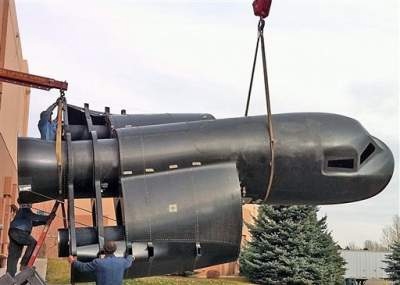Press Release: October 11, 2010
SNC fires hybrid rocket motor and begins production on Dream Chaser Vehicle
Louisville, CO – October 11, 2010 – The Sierra Nevada Corporation (SNC) Space Systems Group announces the successful completion of two critical milestones for NASA’s Commercial Crew Development (CCDev) Program. On September 21, 2010, SNC completed three successful test firings of a single hybrid rocket motor in one day. SNC’s newly opened rocket test facility in San Diego County, California, hosted NASA personnel for a rocket motor manufacturing review as well as the motor firings, including one firing under vacuum ignition conditions. The tests, which simulated a complete nominal mission profile, demonstrated the multiple restart capability of SNC’s proprietary hybrid rocket motor. This same hybrid rocket will be used as the main propulsion system on the Dream Chaser during the orbital operations.

Earlier this summer, SNC completed its second major milestone. This milestone was focused on the development of the primary tooling necessary to build the composite structure of the Dream Chaser vehicle. The tooling required under the milestone has been completed and is now being used to begin fabrication of the first critical aeroshell structures which will be tested later this year. NASA conducted a thorough review of all the elements of the two milestones and has certified milestone completion with no corrective actions.
“The successful completion of these milestones illustrates the value of the partnership between the Sierra Nevada Corporation and NASA. SNC’s rapid hardware development capability, combined with NASA insight and assistance, has resulted in significant real progress on our Dream Chaser human spacecraft. I'm proud of the progress made by our industry/government team,” said Jim Voss, Vice President of SNC Space Exploration Systems. In early 2010, NASA announced that SNC was the winner of the largest CCDev Space Act Agreement aimed at advancing technology and reducing risk for a commercial human spacecraft.
Mark N. Sirangelo, SNC’s Corporate Vice President for Space Systems commented, “SNC has four major milestones under the CCDev 10 month program. All three of our completed milestones were finished on time and on budget. NASA conducted a thorough review of all the elements of the milestones and has certified milestone completion with no corrective actions. I’d like to thank all of our CCDev Dream Chaser team for this terrific accomplishment.”

The completion of these milestones build upon SNC’s long standing successful relationship with NASA. The Dream Chaser spacecraft is based on NASA’s HL-20 crew vehicle, with a strong development heritage. It will launch on an existing United Launch Alliance Atlas V launch vehicle, and will have on-board propulsion utilizing SNC’s proprietary hybrid motor technology. It is a piloted spacecraft which will be able to carry a crew of seven as well as critical cargo to the ISS and other low Earth orbit destinations, and return crew and fragile experiments to a runway landing. This combination of space heritage and proven technology will enable SNC’s unique space transportation system to effectively and reliably carry crew and cargo to low Earth orbit. SNC expects to work in full cooperation with NASA to ensure the highest degree of safety on all aspects of the program and on each mission.
SNC is the prime contractor for the Dream Chaser program and leads a team of experienced space companies working to build and begin to operate this orbital flight system by 2014. The SNC Space Systems Group was formed through the merger of three heritage space companies and has 20 years of space flight experience having participated successfully in over 300 space missions.
About Sierra Nevada Corporation
Sierra Nevada Corporation (SNC) is known for its rapid, innovative, and agile technology solutions in electronics, aerospace, avionics, space, propulsion, micro-satellite, aircraft and communications systems for both the private and public sectors. Founded in 1963, SNC’s seven unique business areas employ approximately 2000 people in 35 different locations in 20 states – all of whom are dedicated to providing leading-edge solutions to SNC’s dynamic customer base.
Over its 46 year history, SNC has remained focused on providing its customers the very best in diversified technologies to meet their needs and has a strong and proven track record of success. SNC has grown into one of the Top Woman-Owned Federal Contractors in the United States while maintaining its reputation for innovation and agility. The company continues to focus its growth on the commercial sector through internal advancements and outside acquisitions, including the emerging markets of telemedicine, nanotechnology, energy and net-centric operations. For more information on SNC visit
www.sncorp.com
MEDIA CONTACT:
jim.voss@sncorp.com or 720-407-3241








